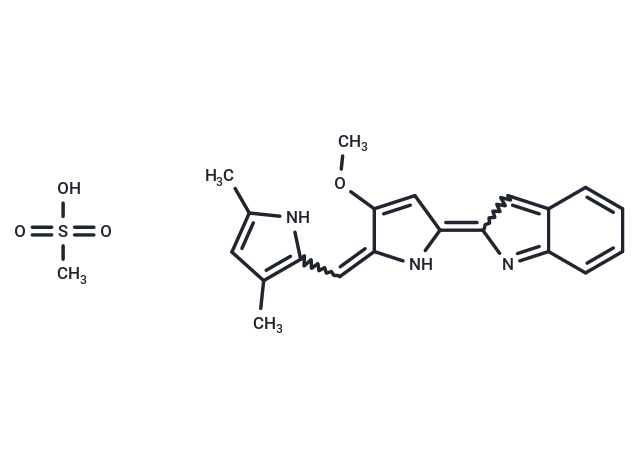Shopping Cart
- Remove All
 Your shopping cart is currently empty
Your shopping cart is currently empty

Obatoclax Mesylate (GX15-070) is a Bcl-2 antagonist (Ki: 0.22 μM) and can induce apoptosis with up-regulation of Bim, induced cytochrome c release, and activation of caspase-3.

| Pack Size | Price | Availability | Quantity |
|---|---|---|---|
| 5 mg | $43 | In Stock | |
| 10 mg | $68 | In Stock | |
| 25 mg | $126 | In Stock | |
| 50 mg | $225 | In Stock | |
| 100 mg | $378 | In Stock | |
| 1 mL x 10 mM (in DMSO) | $48 | In Stock |
| Description | Obatoclax Mesylate (GX15-070) is a Bcl-2 antagonist (Ki: 0.22 μM) and can induce apoptosis with up-regulation of Bim, induced cytochrome c release, and activation of caspase-3. |
| Targets&IC50 | BCL2:220 nM (Ki, cell free) |
| In vitro | Obatoclax (GX15-070) potently interfered with the direct interaction between MCL-1 and BAK in intact mitochondrial outer membrane and inhibited the association between MCL-1 and BAK in intact cells [1]. Obatoclax inhibited cell growth of HL-60, U937, OCI-AML3, and KG-1 cell lines. Obatoclax induced apoptosis in AML CD34+ progenitor cells with an average IC50 of 3.59 micromol/L although clonogenicity was inhibited at concentrations of 75 to 100 nmol/L [2]. Obatoclax reduced the viability of PANC-1 and BxPC-3 cell lines and synergistically enhanced TRAIL-mediated cytotoxicity [3]. |
| In vivo | When formulated for i.v. administration, obatoclax (2 or 3.5 mg/kg) was found to have single-agent antitumor effects in several standard mouse tumor models. Antitumor activity without animal weight loss was observed in mice bearing solid tumors [1]. Thyroid cancer-carrying [Pten,Trp53]thyr?/? mice were treated with vehicle or Obatoclax for 6 days. Live thyrocytes in Obatoclax-treated mice exhibited a dramatic reduction in Lysotracker staining [4]. |
| Cell Research | Cells were plated in logarithmic growth phase at 2,000-4,000 cells per well in 96-well clear bottom plates and cultured for 14 to 16 h before the start of drug treatment. Serial dilutions of obatoclax or companion drug were made in DMSO, diluted 1:50 in RPMI, and then added to tissue culture media at a final concentration of 0.2% DMSO. Cells were typically treated with a dose range of compound from 50 nM to 10 mM for 72 h. Cell viability was then determined using the ViaLight kit, according to the manufacturer's instructions. To obtain percentage viability, samples are expressed as a percentage of the signal obtained from DMSO-treated cells. Dose-response points were then plotted on a log scale, and IC50 values were determined using a best-fit sigmoidal dose-response curve with variable slope. The top of the curve was set to 100% [1]. |
| Animal Research | Cells were transplanted s.c. into the flank of female BALB/c or CB17 SCID/SCID mice (6 to 8 weeks of age) as a suspension in PBS (1.0×10^6 cells/ml, 1.5×10^6 cells/ml, 2.0×10^6 cells/ml, or 5.0×10^6 cells/ml for SW480, C33A, PC3, and 4T1 cells respectively. After 7 (SW480), 14 (C33A), or 8 (PC3 and 4T1) days, treatment with drug was initiated, and body weight and tumor size were measured three times per week. The mean relative tumor size and volume (cohort of eight animals per treatment) were calculated as follows: length (mm) ′ [width (mm)]2/2. Formulated obatoclax (tartrate salt) was administered intravenously (tail vein) once a day ′5 and cisplatin once every 3 days ′ 5 by the i.p. route. Obatoclax was formulated at the indicated concentration in 9.6% polyethylene glycol 300, 0.4% polysorbate 20, and 5% dextrose, except for the 4T1 tumor model where it was formulated at a concentration of 0.6 mg/ml in 9.48% polyethylene glycol, 0.38% polysorbate 20, 1.2 mg/ml mannitol, and 5% dextrose [1]. |
| Alias | Obatoclax, GX15-070 |
| Molecular Weight | 413.49 |
| Formula | C20H19N3O·CH4O3S |
| Cas No. | 803712-79-0 |
| Smiles | CS(O)(=O)=O.COc1cc([nH]c1=Cc1[nH]c(C)cc1C)=C1C=c2ccccc2=N1 |
| Relative Density. | no data available |
| Storage | keep away from direct sunlight | Powder: -20°C for 3 years | In solvent: -80°C for 1 year | Shipping with blue ice. | |||||||||||||||||||||||||||||||||||
| Solubility Information | DMSO: 77 mg/mL (186.22 mM), Sonication is recommended. Ethanol: < 1 mg/mL (insoluble or slightly soluble) | |||||||||||||||||||||||||||||||||||
Solution Preparation Table | ||||||||||||||||||||||||||||||||||||
DMSO
| ||||||||||||||||||||||||||||||||||||

Copyright © 2015-2025 TargetMol Chemicals Inc. All Rights Reserved.